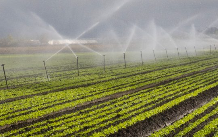Headlines
Political leaning factors strongly in supporting wrongful conviction legislation
LAWRENCE — New research from a University of Kansas political science professor argues that public opinion is consequential for wrongful legislation policy reform. But adoption of such reform is contingent on the ideological leaning of the public, the competitiveness of state elections, the governor’s partisanship and the presence of innocence advocacy groups. The research appears in the September issue of State Politics & Policy Quarterly.
55th edition of Kansas Statistical Abstract publishes new information on Kansas population and more
LAWRENCE — The latest edition of the Kansas Statistical Abstract, which offers information about Kansas across 16 categories, including population and vital statistics, is now available. The Institute for Policy & Social Research at the University of Kansas incorporated 2020 census data in this resource for policymakers, leaders and researchers.
Full stories below.
————————————————————————
Contact: Jon Niccum, KU News Service, 785-864-7633, [email protected]
Political leaning factors strongly in supporting wrongful conviction legislation
LAWRENCE — Since 1989, more than 2,800 people in the U.S. have been exonerated after being wrongly convicted of crimes they did not commit.
Everyone agrees this is a serious issue, right?
Not exactly.
“We tend to think of this as a problem that should be completely non-ideological and devoid of politics,” said Kevin Mullinix, associate professor of political science at the University of Kansas. “But what we found is whether you’re liberal or conservative really matters for the adoption of reforms that address wrongful convictions.”
The reasons why are examined in his new research article titled “The Politics of Wrongful Conviction Legislation.” It argues that public opinion is consequential for policy reform. But adoption of such reform is contingent on the ideological leaning of the public, the competitiveness of state elections, the governor’s partisanship and the presence of innocence advocacy groups. It appears in the September issue of State Politics & Policy Quarterly.
Fundamental to this disparity in opinion is that liberals and conservatives in the mass public embrace profoundly different views about unjust imprisonment.
“They differ in their awareness of the issue and hold contrasting beliefs about the extent to which wrongful convictions are happening,” Mullinix said.
He explained how decades of data suggests that liberals and conservatives clash regarding their trust in law enforcement and the justice system. If conservatives trust the justice system to get it right, to treat people fair and to trust law enforcement, they’re not going to be thinking wrongful convictions are prevalent enough to be concerned.
For example, on one of the surveys while researching this trend, Mullinix asked, “Do you believe an innocent person has been executed in the last five years?” Liberals were 46% likely to agree; conservatives were only 24% inclined to believe the same. Similarly, another question asked, “Have you ever heard of the Innocence Project?” Liberals were 21% more likely than conservatives to be familiar with the nonprofit legal organization committed to exonerating individuals who’ve been wrongly convicted.
“If we’re debating changing all these policies concerning policing, the justice system and wrongful convictions — and some people don’t even think wrongful convictions are occurring — why would they push to change anything?” he said.
Exposure to the factual reality of this issue seems to be tied to what news sources people favor.
“Liberals are far more likely to have heard a true story about a wrongful conviction from traditional news outlets — things like TV news and The New York Times. But when we look at fictional accounts, liberals and conservatives hear about them at the same rate. So when it comes to things like Netflix and entertainment media, liberals and conservatives are more equally exposed to it,” he said.
Fortunately, once awareness is achieved, commonality can be found.
“Providing people with information shifts their attitudes, including conservatives who might not have been aware of the issue. It’s not necessarily that conservatives are opposed to these policies that address wrongful convictions, it’s that they start off with an initial trust in law enforcement and the justice system, and they’re not hearing these contrary accounts,” he said.
Co-written by William Hicks of Appalachian State University and Robert Norris of George Mason University, Mullinix’s article incorporates data from all 50 states between 1989 to 2018. It investigates the adoption of five types of wrongful conviction reforms: 1) changes to eyewitness identification practices, 2) mandatory recording of interrogations, 3) the preservation of biological evidence, 4) access to postconviction DNA testing and 5) exoneree compensation.
According to the National Registry of Exonerations, wrongful convictions are steadily rising. Why is that?
“I think we’re simply starting to catch them more,” he said, noting the NRE only includes exonerations starting in 1989.
“It’s also important to recognize this isn’t a new problem, as if these convictions didn’t occur prior to the 1980s. But now some states have policies where they’re preserving biological evidence longer, keeping more pieces of evidence and having access to post-conviction DNA testing. We’re seeing these numbers climb because we’re perhaps doing better at catching this stuff. We should also pause and reflect on how many potential wrongful convictions we aren’t discovering.”
Mullinix, an expert in public opinion and public policy who has been at KU since 2018, said entertainment shows such as the “Serial” podcast and various true-crime documentaries on television and streaming services actually served as the inspiration for him to tackle this topic professionally.
Previous recent articles credited to Mullinix include “The Feedback Effects of Controversial Police Use of Force,” (Political Behavior, 2020) and “Framing Innocence: An Experimental Test of the Effects of Wrongful Convictions on Public Opinion” (Journal of Experimental Criminology, 2019).
“I honestly don’t think there is a conscious bias against a lot of this wrongful conviction legislation,” he said.
“Liberals and conservatives differ in whether or not they’re even thinking about it in the first place. Because of that, it’s lower on the priority list for some people. What makes it interesting is once it gets on the agenda, it’s kind of difficult to think of an argument against some of these policies.”
-30-
————————————————————————
The official university Twitter account has changed to @UnivOfKansas.
Refollow @KUNews for KU News Service stories, discoveries and experts.
Tweets by KUnews
————————————————————————
Contact: Carrie Caine, Institute for Policy & Social Research, 785-864-9102, [email protected]
55th edition of Kansas Statistical Abstract publishes new information on Kansas population and more
LAWRENCE — The newest edition of the Kansas Statistical Abstract is now available. This document, with the latest available data, offers information about Kansas across 16 categories, including population and vital statistics and health. The Institute for Policy & Social Research at the University of Kansas publishes this compendium of data annually.
The 55th edition of the abstract is informed in part by data collected during the 2020 U.S. census. Conducted every 10 years, the census aims to count each person in the country. Official population counts generated in each decennial census determine representation in Congress and apportion federal funding for states.
“Collecting census data in 2020 was complicated by the pandemic and legal challenges,” said Donna Ginther, Roy A. Roberts Distinguished Professor of Economics and director of IPSR. “These data are essential to government allocation of funds to Kansas and to assuring Kansans their right to representation. Through the Kansas Statistical Abstract, we are pleased to make census data available, and we look forward to adding new data as it becomes available.”
One graph in the abstract, “Population Change in Kansas, by Size of Place,” shows the change from 2010 to 2020 in the population of places grouped by their population size. It shows that places — including official and some unincorporated communities — that are smaller tended to lose population over the last decade while more populous places grew bigger.
A new map, “Percent Change in Housing Units in Kansas, by County,” shows that nine counties in Kansas lost over 10% of their housing units in the last decade. Only three Kansas counties, including Douglas County, gained an additional 10% or more housing units between 2010 and 2020. Changes in housing stock offer additional insight into the movement of people within the state from less populated to more populated places.
The abstract also has population data by congressional district. As the Kansas Legislature plans redistricting ahead of the next election cycle, the 2020 Census counts pose a challenge: the 1st Congressional District lost 2% of the population it had in 2010, while the 3rd Congressional District grew by 11%.
In addition, the abstract includes a new map of Census Designated Places.
These are geographic areas with concentrated populations. They function as communities though they lack official incorporation as a township or other similar entity. Identifying a locality — such as Centerville and Monument in Kansas — means that the Census Bureau can collect and publish data about that place, which helps with emergency management and planning.
Xan Wedel, senior research data engineer, helped identify many of the new Census Designated Places for the 2020 Census as part of her work for the Kansas State Data Center. The Kansas SDC is a partnership between the U.S. Census Bureau and the state of Kansas and consists of a network of Kansas agencies. IPSR serves as the lead agency of the Kansas SDC.
“Understanding the demographic, social and economic characteristics of Kansas is important for business and community leaders as well as policymakers,” said Genna Hurd, IPSR associate researcher and KSA editor. “The KSA covers data on Kansas from health to housing, energy to employment, and poverty to population, including the census 2020 population for counties and cities. We are honored the IPSR and KU have been able to provide this service to the people of the state for 55 years.”
The abstract is used by government leaders, business owners, researchers and others throughout the state.
“There is an overwhelming amount of data available from an endless supply of sources,” said Janet McRae, economic development director for Miami County and frequent user of the abstract. “What I appreciate about the Kansas Statistical Abstract the most is how it saves me time by pulling together comparative, relevant data from reliable sources in a timely manner.”
The Kansas Statistical Abstract includes data in 16 categories published over 17 chapters: Sunflower State Summary; Agriculture; Banking and Finance; Business, Industry, and Exports; Climate; Communications and Information; Courts, Crime, and Public Safety; Education; Employment and Earnings; Energy and Natural Resources; Government; Housing and Construction; Income; Parks and Recreation; Population; Transportation; and Vital Statistics and Health.
The abstract is published both as a downloadable PDF file and in an online edition including downloadable Excel spreadsheets, PDFs and, where applicable, high-quality image files. The abstract is available to users at no cost.
-30-
————————————————————————
KU News Service
1450 Jayhawk Blvd.
Lawrence KS 66045
Phone: 785-864-3256
Fax: 785-864-3339
[email protected]
http://www.news.ku.edu
Erinn Barcomb-Peterson, director of news and media relations, [email protected]
Today’s News is a free service from the Office of Public Affairs




